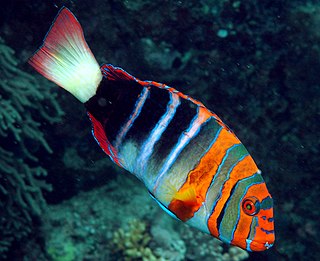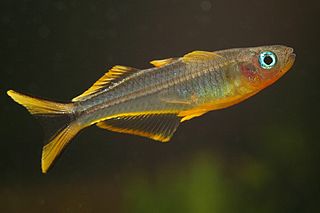
The Old World silversides are a family, Atherinidae, of fish in the order Atheriniformes. They occur worldwide in tropical and temperate waters. About two-thirds of the species are marine, and the remainder live in fresh water. The 74 species are in 13 genera. The genus Craterocephalus is the most diverse with 25 species. Four genera are monotypic.

Parma is a genus of damselfish in the family Pomacentridae.

Choerodon is a genus of wrasses native to the Indian Ocean and the western Pacific Ocean. They are commonly referred to as tuskfish, because most species have sharp tusk-like teeth.

Pseudolabrus is a genus of wrasses native to the eastern Indian Ocean and the Pacific Ocean.

Atherinomorus is a genus of silversides in the family Atherinidae.
Nannoperca is a genus of temperate perches endemic to Australia.

Characodon is a genus of splitfins endemic to north–central Mexico. Two of the species are highly threatened and restricted to pools, ponds and springs in the upper San Pedro Mezquital River basin in Durango. The third species, C. garmani, was restricted to springs near Parras in Coahuila, but it became extinct when they dried out.
The Darling River hardyhead is a species of fish in the family Atherinidae endemic to Australia. The species name amniculus is from the Latin meaning a small creek or stream, in reference to the habitat where these fish are often found.
Kailola's hardyhead is a species of fish in the family Atherinidae endemic to Papua New Guinea. It reaches a maximum length of 6 cm. It inhabits shallow, clear creeks with gravel substrate. This species was described by Walter Ivantsoff, Lucy Crowley and Gerald R. Allen in 1987 with a type locality of a still backwater of Foasi Creek 3 kilometers west of Safia airstrip in Papua New Guinea. The specific name honours the Patricia J. Kailola, for her contribution to the knowledge of the ichthyology of Papua New Guinea.
The Kutubu hardyhead is a species of fish in the family Atherinidae. It is endemic to Lake Kutubu and its outlet, the Soro River, in the Kikori River system, Papua New Guinea. Within its range this species is extremely abundant and large schools may be formed in the shallow margins of the lake, both in open water and among the aquatic vegetation. This species was described by Ethelwynn Trewavas in 1940.
Craterocephalus lentiginosus, the freckled hardyhead is a species of fish in the family Atherinidae endemic to the Kimberley region in the northwest of Australia. It is also called the Prince Regent hardyhead.
The Magela hardyhead or Mariana's Hardyhead, is a species of fish in the family Atherinidae endemic to Australia. It has a very restricted distribution, only found in the Alligator Rivers region of the Northern Territory where it inhabits shallow and fast-flowing freshwater creeks. The fish has a high thermal tolerance, like some other species in the genus Craterocephalus, and may tolerate water temperatures up to 39.5º. The specific name honours Walter Ivantsoff's daughter, Marian.
The Pima hardyhead is a species of silverside in the family Atherinidae which is endemic to Papua New Guinea. This species was described in 1991 by Walter Ivantsoff, Lucy Crowley and Gerald R. Allen with the type locality given as the junction of Pima and Tua rivers. It has not been recorded since the collection of the types.

Pseudomugil is a genus of fish in the subfamily Pseudomugilinae endemic to Australia and New Guinea, where they are found in freshwater rivers and streams and bodies of brackish water.
Kestratherina is a genus of silversides endemic to the eastern Indian Ocean off southern Australia.
Echiodon is a genus of pearlfishes, with these currently recognized species:
Leptatherina is a genus of silversides, one freshwater and one marine, native to Australia.

Craterocephalus marjoriae, commonly known as Marjorie's hardyhead or silverstreak hardyhead, is a species of fish in the family Atherinidae that is native to eastern Australia, namely central Queensland to northeastern New South Wales. Here it inhabits clear flowing streams and it is common among the vegetation in their margins. It prefers shallow water over streambeds consisting of sand or gravel. It forms shoals. They spawn on multiple occasions between September and January, although this peaks earlier in the season. They form pairs for spawning, the eggs being deposited on aquatic vegetation to which they adhere. The eggs are large measuring 1.15-1.25 mm in diameter and have adhesive filaments. The eggs hatch after around a week and the larvae measure about 5.7 mm standard length. Their diet consist mostly of aquatic insects and their larvae, small crustaceans, algae and fish eggs. This species was described by Gilbert P. Whitley in 1948 with the type locality given as Eidsvold on the Burnett River in Queensland. Whitley may have named this species in honour of his sister Marjorie Frewer.
McCulloch's hardyhead is a species of silverside from the family Atherionidae. This species occurs off the coasts of Australia. It was described by David Starr Jordan and Carl Leavitt Hubbs in 1919 from a type locality of Lord Howe Island and the specific name honours the Australian ichthyologist Allan Riverstone McCulloch (1885-1925), who was Curator of Fishes at the Australian Museum and who provided Jordan and Hubbs with the type.

Craterocephalinae is a subfamily of silversides from the family, Atherinidae, the Old World silversides. The majority of the species in this subfamily are freshwater fish, although some occur in brackish water. They are found in Australia and New Guinea.









